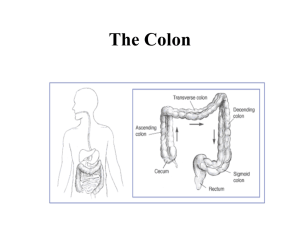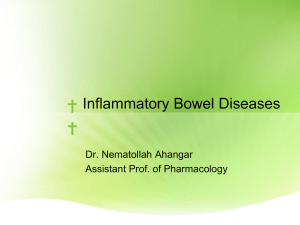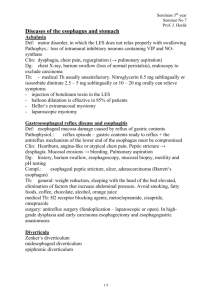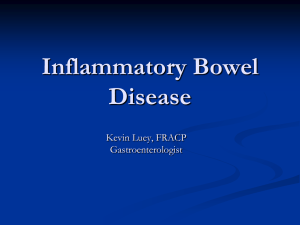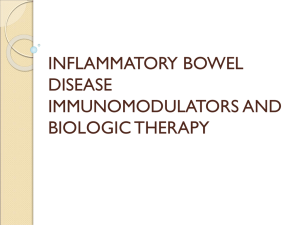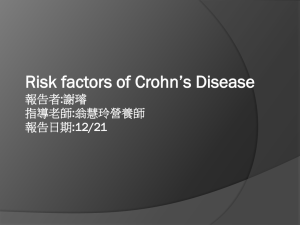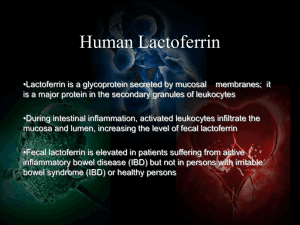Gastroenterology Quiz - Airedale Gp Training
advertisement
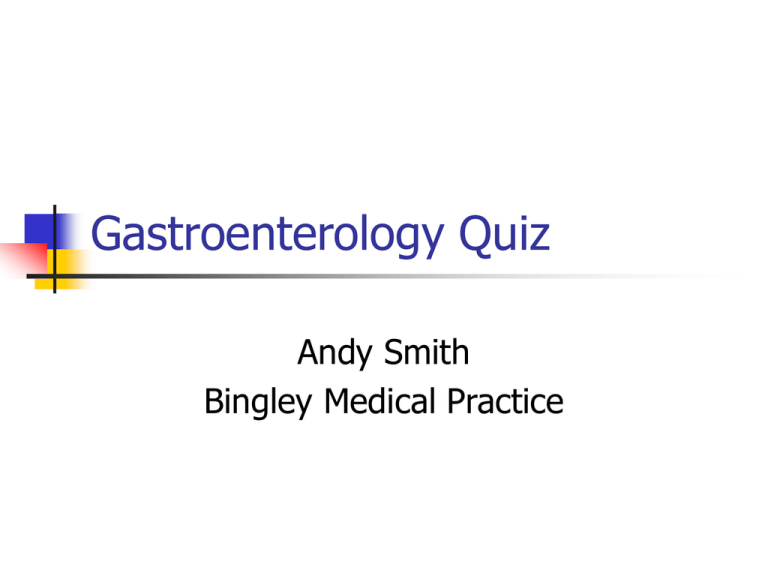
Gastroenterology Quiz Andy Smith Bingley Medical Practice Regarding dysphagia (a) a barium meal is always the first line investigation (b) patients with Barrett's oesophagus should be screened for lower oesophageal basal cell carcinoma (c) it is usually associated with abnormal thyroid function tests (d) is caused by globus hystericus in the majority of cases (e) Oesophageal tumours are most commonly adenocarcinoma or squamous cell carcinoma Regarding dysphagia (a) a barium meal is always the first line investigation (b) patients with Barrett's oesophagus should be screened for lower oesophageal basal cell carcinoma (c) it is usually associated with abnormal thyroid function tests (d) is caused by globus hystericus in the majority of cases (e) Oesophageal tumours are most commonly adenocarcinoma or squamous cell carcinoma - TRUE In alcohol-related liver disease: (a) chronic disease is usually associated with tender palpable hepatomegaly (b) patients are unlikely to be smokers (c) thiamine has not been proven to prevent memory problems (d) decreased tolerance to alcohol indicates progression of disease (e) benzodiazepines are contraindicated during alcohol detoxification In alcohol-related liver disease: (a) chronic disease is usually associated with tender palpable hepatomegaly (b) patients are unlikely to be smokers (c) thiamine has not been proven to prevent memory problems (d) decreased tolerance to alcohol indicates progression of disease - TRUE (e) benzodiazepines are contraindicated during alcohol detoxification In Crohn's disease: (a) there is an association with dermatitis herpetiformis (b) resection of affected segments of bowel is curative (c) Patients are more likely to be smokers than in ulcerative colitis (d) inheritance is autosomal recessive (e) the small bowel is only affected in the setting of backwash ileitis from the colon In Crohn's disease: (a) there is an association with dermatitis herpetiformis (b) resection of affected segments of bowel is curative (c) Patients are more likely to be smokers than in ulcerative colitis - TRUE (d) inheritance is autosomal recessive (e) the small bowel is only affected in the setting of backwash ileitis from the colon Coeliac disease: (a) is the most common cause of malabsorption in developing countries (b) is associated with an increased risk of GI lymphoma (c) patients benefit from a diet high in complex carbohydrates such as bread and pasta (d) is usually diagnosed on CT abdomen (e) patients are at lower risk of osteoporosis than the non-coeliac population Coeliac disease: (a) is the most common cause of malabsorption in developing countries (b) is associated with an increased risk of GI lymphoma - TRUE (c) patients benefit from a diet high in complex carbohydrates such as bread and pasta (d) is usually diagnosed on CT abdomen (e) patients are at lower risk of osteoporosis than the non-coeliac population Helicobacter pylori: (a) is a Gram positive bacterium (b) is associated with over-crowding and lower socio-economic class (c) affects < 1% of the UK population (d) is rarely eradicated by a combination of proton pump inhibitor and antibiotics (e) is a common cause of food poisoning Helicobacter pylori: (a) is a Gram positive bacterium (b) is associated with over-crowding and lower socio-economic class - TRUE (c) affects < 1% of the UK population (d) is rarely eradicated by a combination of proton pump inhibitor and antibiotics (e) is a common cause of food poisoning Ulcerative colitis: (a) is more common in smokers than in non-smokers (b) is treated first-line with infliximab (c) commonly involves the jejunum (d) is associated in most patients with psoriasis (e) is associated with HLA B27 Ulcerative colitis: (a) is more common in smokers than in non-smokers (b) is treated first-line with infliximab (c) commonly involves the jejunum (d) is associated in most patients with psoriasis (e) is associated with HLA B27 - TRUE In irritable bowel syndrome (IBS): (a) mucus may be passed rectally (b) bloody mucoid diarrhoea is common (c) treatment options include 5-ASA compounds (d) symptoms are unrelated to stressful life events (e) a gluten-free diet is first-line treatment In irritable bowel syndrome (IBS): (a) mucus may be passed rectally - TRUE (b) bloody mucoid diarrhoea is common (c) treatment options include 5-ASA compounds (d) symptoms are unrelated to stressful life events (e) a gluten-free diet is first-line treatment Colorectal carcinoma: (a) is classified by Breslow's criteria (b) most commonly metastasizes to the liver (c) is most common in those with a high fibre diet (d) is more common in females than in males (e) patients with disease confined to the bowel mucosa have a 40% 5 year survival rate Colorectal carcinoma: (a) is classified by Breslow's criteria (b) most commonly metastasizes to the liver TRUE (c) is most common in those with a high fibre diet (d) is more common in females than in males (e) patients with disease confined to the bowel mucosa have a 40% 5 year survival rate With regards to Peptic Ulcer Disease (PUD): (a) duodenal ulcers are 10 times more common than gastric ulcers (b) the most appropriate initial investigation is testing for Helicobacter pylori (c) this patient requires urgent endoscopy (d) smoking is not a risk factor for its development (e) duodenal ulcers are more common in patients with blood group A With regards to Peptic Ulcer Disease (PUD): (a) duodenal ulcers are 10 times more common than gastric ulcers - TRUE (b) the most appropriate initial investigation is testing for Helicobacter pylori (c) this patient requires urgent endoscopy (d) smoking is not a risk factor for its development (e) duodenal ulcers are more common in patients with blood group A Gastric cancer: (a) when shown to be an adenocarcinoma on histology, is associated with Helicobacter pylori (b) is usually a squamous cell carcinoma (c) usually has a good prognosis (d) most commonly presents with haematemesis (e) is usually diagnosed on barium swallow Gastric cancer: (a) when shown to be an adenocarcinoma on histology, is associated with Helicobacter pylori - TRUE (b) is usually a squamous cell carcinoma (c) usually has a good prognosis (d) most commonly presents with haematemesis (e) is usually diagnosed on barium swallow Round 2 The best duration of treatment to ensure 90% duodenal ulcer healing with H2 receptor antagonist is: A. 1 week B. 2 weeks C. 4 weeks D. 8 weeks E. 1 year The best duration of treatment to ensure 90% duodenal ulcer healing with H2 receptor antagonist is: A. 1 week - False B. 2 weeks - False C. 4 weeks - False D. 8 weeks - True E. 1 year - True Antacid therapy relieves symptoms: A. Rapidly B. By complete neutralisation of gastric acid C. By eradicating Helicobacter pylori D. Indefinitely E. By protecting the mucosa from acid Antacid therapy relieves symptoms: A. Rapidly - True B. By complete neutralisation of gastric acid - False C. By eradicating Helicobacter pylori False D. Indefinitely - False E. By protecting the mucosa from acid False Body mass index is measured by: A. Weight / height B. Weight2 / height C. Weight / height2 D. Weight2 / height2 E. Weight3 / height Body mass index is measured by: A. Weight / height B. Weight2 / height C. Weight / height2 - True D. Weight2 / height2 E. Weight3 / height Mouth ulcers are more common in: A. Diverticular disease B. Coeliac disease C. Solitary ulcer of rectum D. Ulcerative colitis E. Crohn’s disease Mouth ulcers are more common in: A. Diverticular disease - False B. Coeliac disease - True C. Solitary ulcer of rectum - False D. Ulcerative colitis - True E. Crohn’s disease - True Oral thrush is a frequent finding in: A. Antibiotic therapy B. Oral contraceptive use C. Diabetes mellitus D. HIV infection E. Multiple sclerosis Oral thrush is a frequent finding in: A. Antibiotic therapy - True B. Oral contraceptive use - False C. Diabetes mellitus - True D. HIV infection - True E. Multiple sclerosis - False Dental caries means increased likelihood of: A. Gout B. Subacute bacterial endocarditis C. Alcoholism D. Peptic ulcer E. Dysphagia Dental caries means increased likelihood of: A. Gout - False B. Subacute bacterial endocarditis True C. Alcoholism - True D. Peptic ulcer - False E. Dysphagia - True A high arched palate is seen in: A. Pseudoxanthoma elasticum B. Wegener’s granulomatosis C. Cerebrotendinous xanthomatosis D. Familial hypertriglyceridaemia E. Marfan’s syndrome A high arched palate is seen in: A. Pseudoxanthoma elasticum B. Wegener’s granulomatosis C. Cerebrotendinous xanthomatosis D. Familial hypertriglyceridaemia E. Marfan’s syndrome - True Crohn’s disease affects the lips: A. Rarely B. Sometimes C. Frequently D. Never E. Invariably Crohn’s disease affects the lips: A. Rarely - True B. Sometimes C. Frequently D. Never E. Invariably Parkinson’s disease causes excess dribbling: A. Because of increased salivation B. Because of defective swallowing C. Because patients are tremulous D. Because of festination E. Because of bradykinesia Parkinson’s disease causes excess dribbling: A. Because of increased salivation B. Because of defective swallowing True C. Because patients are tremulous D. Because of festination E. Because of bradykinesia Gastro-oesophageal reflux can reliably be diagnosed by A. Symptoms B. Biopsy histology of the gastrooesophageal junction C. Manometry D. 24 hour pH monitoring E. Bernstein test Gastro-oesophageal reflux can reliably be diagnosed by A. Symptoms B. Biopsy histology of the gastrooesophageal junction C. Manometry D. 24 hour pH monitoring - True E. Bernstein test Round 3 A 40-year-old woman has just returned from a two-week holiday and presents with persistent fatigue, mild right hypochondrial ache and pruritis. She has a good appetite. Alcohol intake increased while on holiday to 14 units weekly; but intake had previously been negligible (less then four units weekly). On examination, she appears to have a slightly enlarged tender liver and palmar erythema. She also has a few xanthelasma. Liver function tests are found to be deranged with gamma GT 520, AST 61, ALT 85 and Alkaline Phosphatase 386. FBC shows a mild iron deficiency anaemia with a low MCV. Ferritin is low. Antimitochondrial antibody test positive. Which is the single most likely diagnosis? a) Alcoholic liver disease b) Carcinoma head of pancreas c) Common bile duct gallstone d) Haemochromatosis e) Primary biliary cirrhosis A 40-year-old woman has just returned from a two-week holiday and presents with persistent fatigue, mild right hypochondrial ache and pruritis. She has a good appetite. Alcohol intake increased while on holiday to 14 units weekly; but intake had previously been negligible (less then four units weekly). On examination, she appears to have a slightly enlarged tender liver and palmar erythema. She also has a few xanthelasma. Liver function tests are found to be deranged with gamma GT 520, AST 61, ALT 85 and Alkaline Phosphatase 386. FBC shows a mild iron deficiency anaemia with a low MCV. Ferritin is low. Antimitochondrial antibody test positive. Which is the single most likely diagnosis? a) Alcoholic liver disease b) Carcinoma head of pancreas c) Common bile duct gallstone d) Haemochromatosis e) Primary biliary cirrhosis - True A 49-year-old man presents with a five-week history of epigastric pain after meals. It is sometimes awakening him in the night. He has also been vomiting and is sure he has lost weight. On examination, you find epigastric tenderness, with no mass nor peritonism. An FBC is normal. Which is the single most appropriate investigation? a) Abdominal ultrasound b) Barium meal c) Serum amylase estimation d) Helicobacter pylori test e) Upper GI endoscopy A 49-year-old man presents with a five-week history of epigastric pain after meals. It is sometimes awakening him in the night. He has also been vomiting and is sure he has lost weight. On examination, you find epigastric tenderness, with no mass nor peritonism. An FBC is normal. Which is the single most appropriate investigation? a) Abdominal ultrasound b) Barium meal c) Serum amylase estimation d) Helicobacter pylori test e) Upper GI endoscopy - True A 50-year-old man presents with reflux-type symptoms for the first time. On questioning, he has had no haematemesis nor melaena, no weight loss and no difficulty swallowing. He has taken bendroflumethiazide 2.5mgs daily for hypertension for the last two years and amlodipine was added four months ago. He states that he drinks less than 10 units of alcohol per week. His BP today is116/70. You decide on an intervention strategy and will review him in four weeks. Which one of the following actions is the most appropriate, at this point in time? a) Commence triple therapy b) Commence lansoprazole c) Cease bendroflumethiazide d) Commence gaviscon advance e) Cease amlodipine A 50-year-old man presents with reflux-type symptoms for the first time. On questioning, he has had no haematemesis nor melaena, no weight loss and no difficulty swallowing. He has taken bendroflumethiazide 2.5mgs daily for hypertension for the last two years and amlodipine was added four months ago. He states that he drinks less than 10 units of alcohol per week. His BP today is116/70. You decide on an intervention strategy and will review him in four weeks. Which one of the following actions is the most appropriate, at this point in time? a) Commence triple therapy b) Commence lansoprazole c) Cease bendroflumethiazide d) Commence gaviscon advance e) Cease amlodipine - True A 55-year-old man has had ulcerative colitis for 20 years. It is usually well controlled on mesalazine 4g daily. Having developed recent back pain, he has been taking ibuprofen 400mg three times a day (which was prescribed for his wife). For the past week, he has had an increase in the frequency of his bowel motions which now occur four times a day and are more liquid than usual. He has had no rectal bleeding or fever. What is the single most appropriate drug adjustment to make? a) Add loperamide b) Add oral prednisolone c) Add rectal prednisolone d) Increase mesalazine e) Stop ibuprofen A 55-year-old man has had ulcerative colitis for 20 years. It is usually well controlled on mesalazine 4g daily. Having developed recent back pain, he has been taking ibuprofen 400mg three times a day (which was prescribed for his wife). For the past week, he has had an increase in the frequency of his bowel motions which now occur four times a day and are more liquid than usual. He has had no rectal bleeding or fever. What is the single most appropriate drug adjustment to make? a) Add loperamide b) Add oral prednisolone c) Add rectal prednisolone d) Increase mesalazine e) Stop ibuprofen - True An 18-year-old girl has been amenorrhoeic for six months. She has lost 5kgs and has developed loose stools, without bleeding, at least four times a day. Carcinoma of colon Campylobacter Crohn’s disease Giardiasis Irritable bowel syndrome Laxative abuse Pseudomembranous colitis An 18-year-old girl has been amenorrhoeic for six months. She has lost 5kgs and has developed loose stools, without bleeding, at least four times a day. Carcinoma of colon Campylobacter Crohn’s disease Giardiasis - True Irritable bowel syndrome Laxative abuse Pseudomembranous colitis A 40-year-old woman presents with intermittent abdominal pain which she says is totally relieved by defaecation. Which one of the following symptoms would suggest further investigations are mandatory? a) Loose stools b) Blood in stools c) Feeling of incomplete evacuation d) Increased stool frequency e) Mucus in stools A 40-year-old woman presents with intermittent abdominal pain which she says is totally relieved by defaecation. Which one of the following symptoms would suggest further investigations are mandatory? a) Loose stools b) Blood in stools - True c) Feeling of incomplete evacuation d) Increased stool frequency e) Mucus in stools For each of the following patients on a GI drug, select the side effect that may relate to it from the list A 75-year-old woman, whose H pylori eradication has failed, is taking Cimetidine. Bezoar formation Bradycardia Deafness Encephalopathy Glossitis Hirsutism Vaginal bleeding For each of the following patients on a GI drug, select the side effect that may relate to it from the list A 75-year-old woman, whose H pylori eradication has failed, is taking Cimetidine. Bezoar formation Bradycardia - True Deafness Encephalopathy Glossitis Hirsutism Vaginal bleeding An 80-year-old woman, who suffers from GORD, is on maintenance Lansoprazole. Bezoar formation Bradycardia Deafness Encephalopathy Glossitis Hirsutism Vaginal bleeding An 80-year-old woman, who suffers from GORD, is on maintenance Lansoprazole. Bezoar formation Bradycardia Deafness Encephalopathy Glossitis - True Hirsutism Vaginal bleeding A 70-year-old woman, with arthritis, is on Misoprostol because Ibuprofen cannot be stopped. Bezoar formation Bradycardia Deafness Encephalopathy Glossitis Hirsutism Vaginal bleeding A 70-year-old woman, with arthritis, is on Misoprostol because Ibuprofen cannot be stopped. Bezoar formation Bradycardia Deafness Encephalopathy Glossitis Hirsutism Vaginal bleeding - Ture Finish – Well done!

